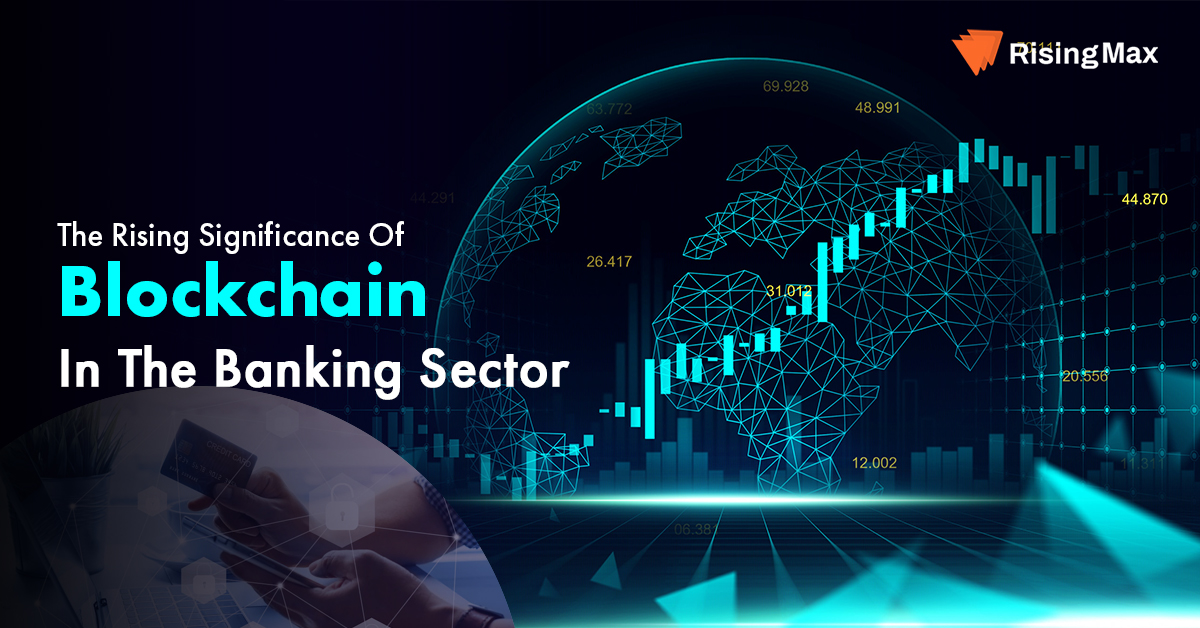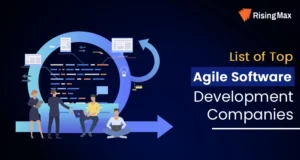The banking and finance sector is one of the early adopters of the new technological trend that can help them to improve their services and serve customers better. Blockchain still in its nascent stages has been assisting the finance sector to reduce costs & risks, improve efficiencies, and unlocking use cases that seems unachievable earlier.

The financial sector seems modernized but, the lack of transparency, clear rules, vulnerability to cyberattacks, lack of interoperability, and security are still its weaknesses.

Since the rise of technology, the banking sector is quickly adapting itself to stay competitive and serve customers better. Blockchain technology is assisting banks and financial systems to solve most of these problems and improve their operations. Banks are now revamping their existing finance structure, transaction speed, and security of the system.
According to Globenewswire, the blockchain market size is expected to reach 67.4 billion by 2026 with a compound annual growth rate (CAGR) of 68.4 percent. Combining all the factors mentioned above there is a huge demand in the market for blockchain developers and development companies.
If you too are looking to build blockchain-based finance solutions, then, we at RisingMax are here to assist you. Our development team is well versed in leading blockchain technologies such as Ethereum, Corda, and EOS, and leverages their expertise to build new-age finance solutions.
In this post, you are going to explore the role of blockchain technology is revolutionizing the banking sector and its use cases of blockchain in banking. But, before diving deep into the topic let’s have a look at this technology first.

How Much Does It Cost to Develop a Fintech App
What Is Blockchain Technology?
Blockchain is a data storage technology, in which information is stored simultaneously on many computers in a decentralized network. The information is stored in the form of interconnected blocks and allows any member within the network to access the stored information in the database at any time. One of the biggest advantages of blockchain technology is that no one can edit, manipulate or delete as the system will automatically update the changes.
On top of that, you can add a security layer and limit the users that can access the information. Thus keeping the information stored on the network secure from any deliberate manipulation and limiting uses access.
Five Major Challenges Traditional Banks Are Facing Today
The financial crisis in 2008, is one of the biggest reasons that the banking sector can be seen as always adapting to new technology and undergoing steady change. However, these changes have started to pose new challenges and problems to the traditional banking system. We have listed five major challenges that the banking sector is facing today that can hinder its future growth if not addressed timely.
Slow Digitalization
Technology is evolving at a very fast pace and the traditional banking system has been slow in keeping up with these changes. Till now banking sector is providing online services like deposits, bank transfers, cheque applications, credit/debit card applications, bill payments, etc.
According to recent reports, the banking sector can reduce the overall working cost to 60-80 percent with blockchain technology. However, slow digitalization proved a hindrance in the pathway of banks to perform at their optimal efficiency.
Old Banking Infrastructure
The banking sector around the world is still dependent on old banking infrastructure composed of core banking solutions (CBS). This old banking system is completely dependent on rigidity to provide stability and security. However, with modern technology banks can adopt an agile approach and change or modernize parts of the system that are not beneficial for the system. The priority of the banking system is to remain risk-averse and move toward better and more efficient technology.
Banking Regulatory Standards
The banking sector is confined to complying and working with the set regulatory standards by the supervising authority. Banks in Europe and North America follow regulatory standards like PSD-2 and MiFID while on the other hand, Indian Banks need to comply with standards capital-asset ratio, a cash reserve ratio, and a statutory liquidity ratio. Failure to meet these banking regulatory standards can result in heavy penalties from the supervising authority.
FinTech Solutions
FinTech software solutions are revolutionizing the banking sector and making it quick, efficient, user-friendly, and more accessible to users worldwide. The banking sector needs these software solutions to widen its user base and efficiently provide services. FinTech solutions are posing a major challenge to the traditional banking system to advance with this ultra-modern technology and serve customers better.
Bank-Customer Engagement
After the 2008 financial crisis, most people lost their faith in the banking system and are a bit skeptical about how the entire system operates. Even though the banking sector has gone through some major reforms and expanded its services.
But still, there is mistrust among people due to the lack of transparency in the system which is not good for the sector in the long run. However, with the use of blockchain in the banking sector, things are looking quite good for banks worldwide.
The technology is making the banking sector user-friendly, transparent, and more secure than ever before. Thus boosting users’ trust and confidence in the banking system.
Each of the five major issues with the traditional banking system mentioned above poses a different challenge. To deal with these challenges there is no need for the banks to either redesign the entire system. But, to use these innovative technologies in the pain areas of the banking system and be open to change.

Blockchain Use Cases In Banking Sector
Payment Transfers
Banking sectors are using blockchain technology to provide users with faster, safe, and secure payment transfers. In addition, the technology is also lowering the cost of sending payments, reducing processing time, and fees. With reduced payment transfer time, lower processing fees, and more secure payment transfer technology, banks are offering a new level of services to their customers. One of the uses of blockchain technology in banking is it allows banks to cut down their dependencies on third parties and offer more swift payment transfers than traditional bank transfers.
Clearance & Settlement
Clearance and settlement of funds are one of the major pain areas for the banking sector. Both of them are time taking process and needs constant tracking to ensure timely clearance and settlement. In the traditional banking system, it usually takes a few days to settle fund transfers as this is how our financial infrastructure was built. Whenever there is a transfer of money it needs to go through a complex pre-defined process before it reaches the end destination.
However, with blockchain technology, things are changing for good for the banking sector. The baking sector is using blockchain technology to speed up the clearance and settlement process. Banks are reducing their dependencies on custodial and regulatory bodies like SWIFT. Moreover, all the transactions are visible to the users publicly which brings transparency to the system.

Blockchain Use Cases In Banking
Securities
Whenever there is an instance of buying and selling securities like stocks, properties, commodities, etc. The process becomes cumbersome and complex due to the involvement of multiple intermediaries like exchanges, clearing houses, custodial banks, property brokers, and others.
As you can guess, the traditional banking system is quite a riddle for new users and is even prone to deception. Blockchain technology gave the ability the banks to remove intermediaries during the buying and selling of securities. Thus simplifying the overall process and lowering the asset exchange fees.
Speeding Loan Process
In the traditional banking system, banks evaluate risks while giving out loans depending upon various factors such as credit score, debt to income ratio, etc. The process is quite complicated and requires a fair amount of time before deciding the eligibility of a person.
However, blockchain technology is working to completely revolutionize the entire loan process system and replace it with a better peer-to-peer loan system. P2P is a revolutionary loan processing and approval process that is a more secure, cheap, and fast process than the traditional system.
Accounting and Auditing
The strict rules and changing regulations are one of the major reasons why the banking sector finds it hard to adapt to new technology. The addition of new technology is followed by the instant need to match it with strict regulatory compliance.
However, all of this can be easily transformed with blockchain technology as all the information is stored on a decentralized network. As data is available for everyone within the blockchain network. Thus, making it easy to audit as all the information due to data stored in a distributed ledger.
Peer-To-Peer Transfers
In the traditional banking system, due to regulatory rules, there are often hindrances in transferring funds within geographies. However, with blockchain technology, it’s now easy to transfer funds with no geographical barriers.
In addition to this with P2P transfers, banks can transfer funds worldwide, and that too at lower transfer fees. Blockchain technology ensures that during funds transfer there is no sharing of any sensitive customers’ data and information is stored in a decentralized system ensuring transparency.
Customer KYC
Know your customer (KYC) is a critical process in the banking sector for onboarding customers. KYC verification procedures like photo verification, identity proof, mail address proof, biometrics, etc is time taking process. In some cases, this verification process might take up more than 2-3 months to complete the process. However, with blockchain technology banks can now reduce the KYC verification time and speed up the entire process to ensure smooth onboarding of customers with the security of blockchain.
Final Words
With this post, you have viewed the increasing role of blockchain technology in the banking sector. From bringing innovation to the sector to reducing transaction costs to expediating the entire process, the technology is pushing the banking and finance sector towards a better future.
For this very reason, banks and financial institutions are partnering with trusted blockchain development companies and building next-gen software solutions in the banking domain.
If you are looking to build a reliable, secure, and scalable FinTech or banking blockchain-based software solution. Then, our blockchain experts at RisingMax are just a few clicks away from turning your app idea into reality.
Book a call with us today.











